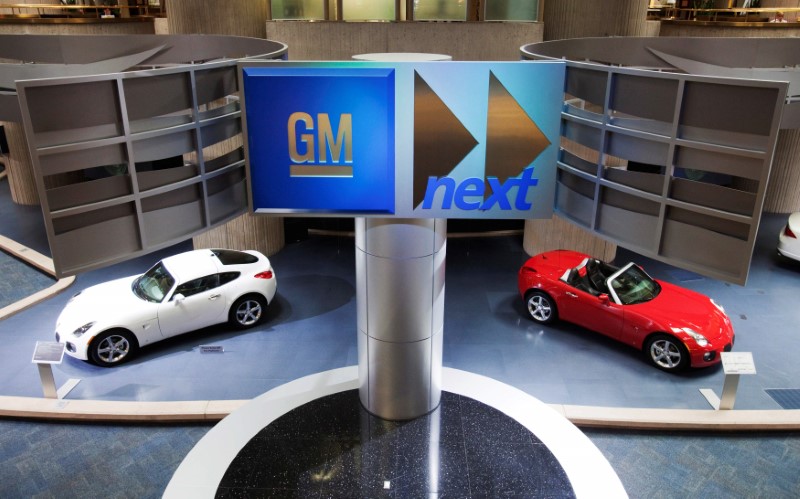© Reuters. FILE PHOTO: United Auto Workers President Shawn Fain greets workers at the Stellantis Sterling Heights Assembly Plant, to mark the beginning of contract negotiations in Sterling Heights, Michigan, U.S. July 12, 2023. REUTERS/Rebecca Cook/File Photo
2/2
By Joseph White
DETROIT (Reuters) – United Auto Workers President Shawn Fain is not a shouter. When he addresses union members in Facebook (NASDAQ:) videos, or appears in public, he rarely raises his voice.
But what Fain tells UAW members and the language he uses to frame the union’s goals represent the most aggressive challenge in three decades to the labor status quo at unionized Detroit automakers General Motors (NYSE:), Ford and Stellantis .
“The only real limits we have are the ones we place on ourselves,” he told union members in a video address on Tuesday. “We refuse those limits because there are no limits.”
Over and over, Fain has told the UAW’s 150,000 members at the Detroit Three that in the contract bargaining that began this week they can reverse 20 years of wage and retiree benefit concessions, stop further plant closures and end a seniority-based, tiered compensation system that pays new hires as much as 44% less than veteran workers.
“I’ve been told I am crazy to raise member expectations this high as we head into bargaining,” Fain said in the Facebook Live talk on Tuesday. “I refuse to allow employers, the billionaire class and sellouts to play on our fears.”
The 54-year-old union veteran, who carries his UAW-member grandfather’s pay stubs in his wallet, delivered this message wearing a black T-shirt with a quotation from U.S. civil rights leader Malcolm X on the back.
Paraphrasing the fiery 1960s activist, Fain said, “If you truly value freedom, you must fight for freedom by any means necessary … How far are you willing to go to win the contract you deserve?”
The goal of what Fain calls the UAW’s “contract campaign” is to break with two decades of UAW leadership that sought to slow the loss of jobs at the Detroit Three by agreeing to wage concessions and acquiescing to plant shutdowns.
The first UAW leader to win office in a direct vote by rank and file members, Fain is bringing political campaign tactics to his administration. He has asked UAW members to sign cards with their email addresses and phone numbers – harvesting information the union can use later to test support for its bargaining positions, or call members to action.
Fain has visited Washington and encouraged supportive officeholders such as Senator Bernie Sanders to amplify the UAW’s position that Detroit automakers reaping billions in subsidies for electric vehicle production should pay more to workers at EV battery plants.
LONG-TERM TECHNOLOGY THREATS
The UAW president is unsparing in criticism of his immediate predecessors – two of whom, Dennis Williams and Gary Jones, were convicted of corruption. The repudiation of past leadership and bargaining strategy is winning support from local union leaders and members.
“We’re still sitting on things we gave up in 2009, we haven’t gotten those back,” said Matt Frantzen, president of the UAW local that represents Stellantis’ Belvidere, Illinois, Jeep factory. The plant is idled and targeted for shutdown – a move Fain has vowed to stop.
“He’s definitely the right guy for the time – that whole board is,” Frantzen said. “Membership is behind him.”
The crucial test for Fain’s strategy will come on Sept. 14, the day the current contracts with the Detroit Three expire. In 2019, the union launched a strike against GM when the company refused to agree to a contract by the deadline. That six-week strike cost GM $3.6 billion and stressed the finances of UAW members.
The union has since beefed up its strike fund, and this year’s bargaining is taking place at a time of low unemployment. Analysts say the chances of a strike, possibly even multiple walkouts, are high. Other unions, including Teamsters at delivery giant United Parcel Service (NYSE:) and writers and actors in Hollywood, have been emboldened.
But like other unions, the UAW members at the Detroit Three face longer-term threats from new technology that a richer contract will not resolve.
Meanwhile, the automakers are aiming for greater flexibility in their workforces and want to make themselves more competitive not only with foreign automakers like Toyota, but also EV market leader Tesla (NASDAQ:).
The shift from combustion-engine vehicles to EVs with the data-processing capability of supercomputers means Fain and his successors must look beyond traditional auto factories, said Peter Berg, a labor relations professor at Michigan State University.
“The ability of the UAW to organize semiconductor plants, EV plants in California, joint ventures is going to be critical for the union,” he said.
Read the full article here












